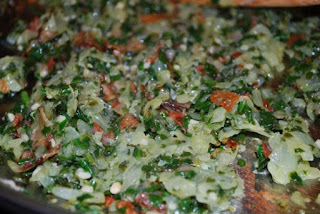I am always looking for new ways to eat chicken.
I recently prepared this recipe on a KOLR-10, Ozarks Live segment. Perhaps you saw it.
The recipe is really easy to make.
Ingredients
2 chicken breasts thinned to about 1/4 inch thick (I put
each chicken piece in between two pieces of saran wrap and pounded them with my
mallet)
1 onion (yellow or white), chopped
1 cup chopped spinach
2 cloves garlic
4 pieces of cooked bacon, crumbled into smaller pieces
Olive Oil
Salt and Pepper
coarsely ground almonds (I used my Magic Bullet.)
Toothpicks (to hold the chicken together!)
Heat a couple tablespoons of olive oil in a saucepan and
sauté onions and garlic for about 5 minutes. Add spinach and bacon
pieces, cook a few minutes more until it looks something like this…
Take your thinned out chicken breasts and place them on a cookie sheet. Divide the spinach onion mix and spread onto the chicken. Like this…Except my chicken breast was more flat this this picture.
Roll chicken up and secure with a couple toothpicks. Brush
with a little olive oil and sprinkle with salt and pepper. Have your
coarsely ground almonds (I put my whole almonds in the food processor and gave
it a couple grinds until they were in small little chunky pieces). Roll your
chicken into the almonds and place on a baking sheet. Bake at 350 for 30 – 35
minutes. When it comes out of the oven it will look something like this…
ENJOY











